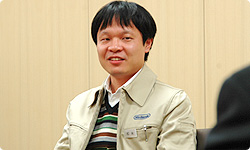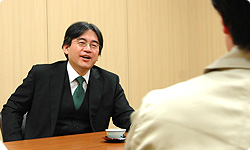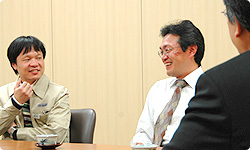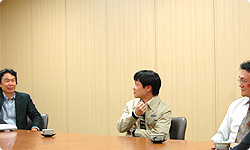2. The Team that Almost Broke Up
And so, because your repeated attempts to discuss your ideas with scales manufacturers were going nowhere, you decided to make the accessory yourselves. But then the focus switched from ordinary bathroom scales to an accessory that could even measure your balance, which I imagine was a major turning point for the Wii Fit project. Sawano-san, the hardware planner, mentioned in the last interview that the idea for a machine that could measure balance was inspired by the fact that sumo wrestlers weigh themselves on two scales placed side-by-side. When did you software developers first hit on the idea of implementing balance measuring?
I was doing a lot of Internet research when I discovered a Seitai3 therapy method for maintaining good posture that involved the use of two scales. Soon afterwards, I discussed the idea of measuring balance with Miyamoto-san. 3 A combination of acupressure, spinal manipulation and nutritional therapy designed to strengthen the body internally.
That’s a very interesting story. Both you and the hardware teams were asked to come up with something that involved the use of scales, and both of you came up with the same concept of measuring balance – except the hardware team found the idea in sumo wrestling, and the software team found it in Seitai therapy.
Exactly. I knew by then that ordinary bathroom scales couldn’t offer us anything more than they already did, so I spent a lot of time just thinking about what would make an accessory similar to bathroom scales look new and interesting, and in the process ended up with the concept of measuring balance. Next, as Miyamoto-san talked about in the first part of this series, we tested a program that would calculate the balance of a person standing on two bathroom scales and display the figure as two percentages on-screen. Everybody really enjoyed this test. It was really difficult keeping the balance at 50-50, which would have of course required zen-like concentration to achieve. We decided that this was the ultimate challenge, and we’ve kept it alive in the final version of Wii Fit as an Easter egg.
When you were given the concept of balance to work with, Matsunaga-san, what did you think?
I thought that this was what was going to be our breakthrough. Until then, I had just been racking my brain to come up with something I could use with this concept of “health”, and I would have been happy to listen to just about any idea.
As a matter of fact…just before coming up with the balance idea, our team was on the verge of being broken up because we just weren’t coming up with anything.
Broken up?! Those are grave words for a producer, aren’t they? (laughs)
(laugh)
Before coming up with the balance idea, every idea we’d presented to Miyamoto-san had been rejected, and things were getting so bad that team members were openly arguing with each other.

And so we were having a rough time trying to find ways in which an accessory similar to bathroom scales could be used in gaming, and had come to realise the limitations of thinking around ordinary scales. The mood of the team at the time was in tatters, and our motivation just kept dropping. We’d even told ourselves that we’d give up this project if the balance idea didn’t pan out. Of course, deep down, we knew that this was the idea that would make this project work! (laughs)
And so the balance idea rescued the team from being broken up. We really owe those sumo wrestlers and Seitai therapists one now! (laughs) But were you really that confident about the balance idea from the very beginning?
When we were playing around with the two-scales idea, I sensed that there was a lot of potential in this balance idea. It took us about a week to set up the system, but after that all the pieces fell into place pretty quickly.
Things began to move along really quickly once you came up with that one good idea, didn’t they? Although, according to Sawano-san, the software developers were not initially keen on his idea to add front and back balance recognition to the Wii Balance Board…

That idea didn’t come up until quite a while after a lot of trial and error had gone into developing the design of the accessory. I personally believed that the Wii Balance Board would work perfectly well with just left and right balance recognition and that plenty of enjoyable games could be created within just those limitations. And then, right in the middle of development, this talk about adding front and back balance recognition came up. I spent a lot of time thinking about how to use this new function, but I was also a little worried that this would make the controls too difficult. Besides, we’d just spent a whole lot of time and effort coming up with the balance idea, and the project finally seemed like it was going to take off, so it felt like we were given yet another problem to deal with.
That must have been an unwelcome surprise. It must have looked like he was just setting up another tea table for Miyamoto-san to upend! (laughs)
(laugh)
I heard that, at the same time, Miyamoto-san instructed you to look for a physical trainer specialising in body balance.
Yes. Mr Kaoru Matsui supervised the athletic elements of this game, but I actually found him quite by chance while looking for balance-based training programmes on the Internet. When we met him, he seemed very knowledgeable about posture and was very interested in what we had to say. So he agreed to work with us on the game right there and then.
So you and Matsui-san hit it off immediately?
As I expected, he seemed a bit surprised at first that someone from Nintendo would want to talk to him! (laughs) But during my Internet research, I found the website of the gym he works at, and there was this image of two bathroom scales placed side-by-side. He was clearly already doing what we wanted to do, and I was positive that he would be receptive to our ideas.
So it was almost like a fated encounter.
When we first went to talk with him, the Wii Balance Board was still a square because we were still going with the bathroom scales motif, and it was still too narrow to do the exercises in the Yoga and Muscle Workouts sections of the game. So we started talking about maybe designing these sections to function like your typical fitness DVD, in that you work out on the floor while watching a trainer doing the same on the screen. We compiled footage of a number of trainers doing different exercises and showed the movie back at the company to see what everyone thought. While we did so, Miyamoto-san suddenly shouted “That’s it!”
Come again?
We just looked back at him puzzled, because we had no idea what he was going on about. And then he got angry and told us off for that.

I was there at the time, and I didn’t know what he was talking about either. I was just confused as to what he was getting angry at us for! (laughs)
Ah, I see, I know exactly what you’re talking about. It’s the same feeling I get when Miyamoto-san calls me out of the blue and tells me, “I’ve got it!” When he says something like that, he’s usually the only one who gets it! (laughs)
It’s so true! (laughs) It was only after he explained it to us later that we understood what he was trying to say. Basically, he noticed that the natural stance before training is to stand with your feet apart at about shoulder width.
In other words, a board the size of your average bathroom scales would have been too narrow. So that’s how you came to realise that the Wii Balance Board needed to be at least shoulder width.
I was just plain confused when Miyamoto-san shouted out, “I got it!” But in retrospect, that was a pivotal moment for all of us. From then on, development was a breeze. But at the time, it hadn’t even occurred to me that the size of the Wii Balance Board could be increased…
Go ahead, be honest! I don’t mind if you have to say something nasty about me. I could leave the room if you want?

(laugh)
For those readers who are wondering what’s going on, I should clarify that, yes, Miyamoto-san has been sitting through this interview the whole time. (laughs) Well, Sugiyama-san, how about it? Care to tell us how you honestly felt?
From the beginning of the scales project, Miyamoto-san had constantly reminded us to keep the costs for the Wii Balance Board as low as possible. (laughs) That’s why the last thing on our minds was to make the Wii Balance Board bigger. Even the slightest increase in size would have naturally increased the cost of the product, so the only thing we were focusing on was to make the Wii Balance Board as compact as possible.
However, it was a single fitness DVD that sealed the eventual size of the Wii Balance Board.
I feel sorry that my instructions kept causing havoc in the workplace, but I really do believe that it’s important to experience the elements you introduce in a game for yourself. When designing Epona4 for Twilight Princess, for example, we visited an equestrian club. For Wii Fit, I had the developers go to a gym and experience a variety of exercises for themselves. I just watched and laughed! (laughs) 4 A horse character featured in The Legend of Zelda: Twilight Princess.

I wish I’d seen that too! (laughs) It reminds me of how work on Rhythm Tengoku5 started after the development team started taking dance lessons from Tsunku. 5 A Game Boy Advance game released only in Japan in August 2006 that was produced by Japanese entertainment mogul Tsunku.
